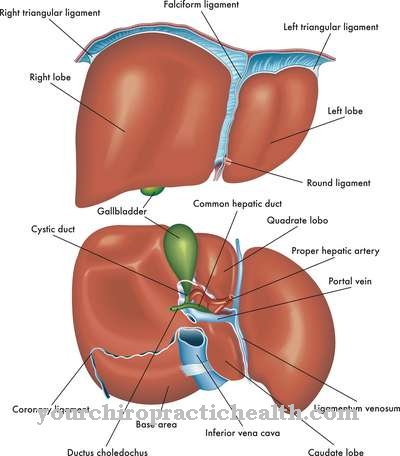The Glanzmann's thrombasthenia belongs to the rarer blood clotting disorders. In a more severe form, it can be fatal if the patient is not treated with the correct means in a timely manner. It occurs as a hereditary and acquired disease and can - depending on the form and symptoms - be a great psychological burden for the person concerned. Since children are at a higher risk of injury anyway due to their behavior, they are particularly at risk when accidents occur.
What is Glanzmann's thrombasthenia?

© Matsabe - stock.adobe.com
Glanzmann's thrombasthenia was named after its discoverer, the Swiss pediatrician Eduard Glanzmann. The hereditary form of the very rare platelet coagulation disorder is also called hereditary thrombasthenia, GT, Glanzmann-Naegeli syndrome and Glanzmann Naegeli's disease designated. Platelet disease is inherited in an autosomal recessive manner and skips several generations before recurring.
The parents of the newborn often do not know that they are carriers because they do not notice any symptoms themselves. Patients have an increased tendency to bleed, which can range from milder forms of the disease (punctiform skin sub-bleeding) to fatal complications during surgical interventions. Therefore, it is very risky for those affected to have even minor surgical interventions carried out if they themselves and / or the doctor performing the operation are not aware of the disease.
How widespread the blood disease is among the population cannot be precisely determined. What is certain, however, is that it occurs equally frequently in men and women. Carrier women can carry their child normally, but they should definitely seek advice before a planned pregnancy. In addition to the hereditary form of Glanzmann's thrombasthenia, there is also the acquired form.
causes
In the inherited form of Glanzmann's thrombasthenia, the disease only occurs in the child if both parents are carriers of the genetic defect. If only one parent is the carrier or is sick themselves, then the statistical probability is 50 percent that the child will get sick themselves. If the parents are related, the risk for the child of developing Glanzmann's thrombasthenia is very high.
The disease affects the glycoprotein receptor GPIIb / GPIIIa (alpha-2b / beta-3 integrin) on chromosome 17. It is either completely absent or does not work properly. The receptor on the gene ensures that the platelets clump together where the blood vessel is injured (blood clotting, aggregation). If the receptor is not fully functional, the fibrinogen that clumps together the platelets, the von Willebrand factor and the fibronectin cannot dock there. Bleeding cannot be stopped at all or only with a long delay.
The acquired Glanzmann thrombasthenia occurs in the context of malignant diseases (Hodgkin lymphoma, multiple myeloma, leukemia). In this form of the disease, the body produces autoantibodies against the GPIIb / IIIa receptor. Hodgkin's lymphoma is a malignant lymph gland tumor. In multiple myeloma, the malignant cancer cells in the bone marrow grow so fast that bones break. The resulting platelet deficiency also increases the risk of bleeding.
You can find your medication here
➔ Drugs for wound treatment and injuriesSymptoms, ailments & signs
Patients with Glanzmann's thrombasthenia have an increased tendency to bleed. They will only stop after a long period of bleeding, or no clots will form at all. The first symptoms appear before the age of 5. However, the disease is usually not diagnosed until later in life.
The mild form of platelet dysfunction shows up in minor skin bleeding (punctiform, small-spotty), gum and nosebleeds, excessive menstrual bleeding in women and multiple skin bleeding (purpura).
They occur in the context of injuries, but also often spontaneously. Larger hematoma-like skin sub-hemorrhages have a striking cherry-red color. In severe cases, there is bloody vomiting, gastrointestinal bleeding (tarry stool), blood in the urine and severe life-threatening bleeding during surgery and bleeding. Hypovolemic shock can occur during childbirth. Most sufferers from the mild form of the Glanzmann-Naegeli syndrome.
diagnosis
Glanzmann Naegeli's disease is diagnosed on the basis of the findings of the skin sub-bleeding (type and extent) and the absence of platelet aggregation while the number and shape of blood platelets are normal. Using flow cytometry, the doctor can determine the type of genetic defect. If the disease is detected early, the prognosis for the patient is favorable.
Complications
Without treatment, Glanzmann's thrombasthenia can lead to death. In most cases, in addition to the physical complaints, there is also strong psychological stress and in most cases also depression. Those affected tend to bleed in different parts of the body. This can lead to an increased risk of injury, especially in children, so that they are particularly badly affected by the disease.
For the patient there are considerable restrictions in everyday life. The bleeding occurs mainly on the gums or nose. In women, this results in increased bleeding during their period. This can lead to significant mood swings. It is not uncommon for the blood to appear in the urine or stool, which in many patients primarily leads to a panic attack.
Internal bleeding can, however, be life-threatening, so that urgent treatment is necessary for the patient. Complete cure and causal treatment are not possible in the case of Glanzmann's thrombasthenia. However, the symptoms and the duration of the bleeding can be limited to such an extent that it does not reduce the lifespan.
When should you go to the doctor?
Adults or children who bleed unusually intensely even with minor injuries should see a doctor. If the bleeding from open wounds cannot be stopped or can only be stopped after a very high blood loss, a doctor's visit is necessary. A life-threatening condition threatens that must be medically examined and clarified. If you feel dizzy due to the loss of blood, if you feel unsteady or drowsy, you should be careful.
To avoid an increased risk of accidents, the person affected should rest. A doctor should then be consulted. If frequent nose or gum bleeding occurs during physical activity, a doctor should be consulted. Women and sexually mature girls who have very heavy menstrual bleeding should see a doctor.
If you experience dizziness, reduced performance or fatigue during your menstrual period, you should seek medical care. If you have blood in your stool, urine or discharge, you should consult a doctor.
If blood is also spat out when vomiting, there is cause for concern. If the bleeding persists, impaired consciousness or loss of consciousness, an emergency doctor must be called. Until the emergency services arrive, the instructions of the medical staff should be followed and attempts should be made to stop the bleeding.
Doctors & therapists in your area
Treatment & Therapy
Glanzmann's thrombasthenia is treated with anticoagulant drugs and the hemostatic agent desmopressin (DDAVP) in order to avert life-threatening consequences for those affected. Hemostatics act on the release of the malfunctioning receptor. If the affected person cannot be helped with this, platelet concentrates are transfused. This also happens during operations.
However, 15 to 30 percent of patients treated in this way develop antibodies. Today, the recombined coagulation factor VIIa (human fibrinogen) is often given as an alternative. The removal of the spleen, which has hitherto been regarded as ineffective, also improves the patient's condition. Even people with no clot formation stop developing severe symptoms and have high platelet counts. It can also reduce the bleeding time.
Outlook & forecast
The genetic disease cannot be cured. Due to legal requirements, human genetics must not be changed. For this reason, patients with Glanzmann's thrombasthenia receive symptomatic treatment. In severe cases, the blood clotting disorder can be fatal. Sick people tend to have more bleeding than they normally do. If there is no timely medical care, the affected person can bleed to death and thus die prematurely.
The course of the birth represents a particular risk. There is a risk of sudden death for the newborn. Due to the symptoms and their consequences, it is absolutely necessary to seek medical care in the event of abnormalities or an increased tendency to bleed in the course of life. It influences further development and thus the prognosis to a considerable extent.
Although the Glanzmann thrombasthenia is not curable, long-term therapy and immediate action in the event of irregularities can achieve an elementary improvement within the organism of the person concerned. Injuries must be treated immediately by a doctor so that bleeding can be stopped as quickly as possible.
If the administration of medicines is successful, there is a clear improvement in the state of health. The overall occurrence of bleeding is reduced. In addition, the loss of blood in the event of injuries is documented to a lesser extent.
You can find your medication here
➔ Drugs for wound treatment and injuriesprevention
A prevention is not possible in the case of Glanzmann's thrombasthenia, as it is either inherited or syndromic in the context of certain diseases that are acquired later. The only way to reduce the incidence of bleeding, at least in terms of quantity, is to avoid injuring yourself as much as possible. Spontaneous nosebleeds can be prevented, for example, by avoiding violent head movements, and bleeding gums by gently brushing your teeth carefully.
Aftercare
As a rule, no direct follow-up options are possible or necessary in the case of Glanzmann's thrombasthenia. The focus is on the early detection and treatment of the symptoms in order to prevent further complications. Since Glanzmann's thrombasthenia is a hereditary disease, genetic counseling should be carried out if you want to have children in order to prevent the disease from being passed on.
In general, those affected by Glanzmann's thrombasthenia need special protection in the event of injuries or bleeding. An ID should also be worn, which indicates the illness, in order to guarantee fast and correct care by a doctor. In the event of medical examinations or surgical interventions, the doctors must be informed about the Glanzmann thrombasthenia so that there are no further complications.
In many cases, the disease can be treated with a surgical procedure, whereby this procedure must be carried out several times in order to permanently alleviate the symptoms. After the procedure, the person affected should always rest and take care of their body. Further measures are usually not necessary. The life expectancy of the patient is usually not reduced by the Glanzmann thrombasthenia, provided that heavy bleeding is avoided.
You can do that yourself
As a rule, Glanzmann's thrombasthenia can only be treated or supported to a very limited extent by self-help measures. The patients are primarily dependent on symptomatic treatment by a doctor.
In general, bleeding must always be avoided. This is especially the case with children, as they can easily injure themselves. Parents must take special care of their children to avoid any bleeding. Spontaneous nosebleeds should also be avoided by ensuring that the person concerned does not make any violent or jerky head movements. The same applies to bleeding gums, although this can be avoided by properly and regularly caring for your teeth and by using a mouthwash.
In the case of surgery, the doctor must always be informed about the Glanzmann thrombasthenia in order to avoid complications. Children should always be fully informed about the disease. This also includes providing information about the risks and complications that can arise from heavy bleeding. Contact with other affected persons can lead to an exchange of experiences, which may have a positive effect on the everyday life and quality of life of the patient.




.jpg)



















.jpg)



